(医疗药品管理)ICHQA原料药(中英文)
- 格式:doc
- 大小:836.61 KB
- 文档页数:295

ICH 三方协调指导原则E6 ICH GCP指导原则INTRODUCTION前言Good Clinical Practice (GCP) is an international ethical and scientific quality standard for designing, conducting, recording and reporting trials that involve the participation of human subjects. Compliance with this standard provides public assurance that the rights, safety and well-being of trial subjects are protected, consistent with the principles that have their origin in the Declaration of Helsinki, and that the clinical trial data are credible.临床试验管理规范(GCP)是设计、实施、记录和报告设计人类对象参加的试验国际性伦理和科学质量标准。
遵循这一标准为保护对象的权利、安全性和健康,为与源于赫尔辛基宣言的原则保持一致以及临床试验数据的可信性提供了公众保证。
The objective of this ICH GCP Guideline is to provide a unified standard for the European Union (EU), Japan and the United States to facilitate the mutual acceptance of clinical data by the regulatory authorities in these jurisdictions. ICH-GCP指导原则的目的是为欧盟、日本和美国提供统一的标准,以促进这些管理当局在其权限内相互接受临床数据。
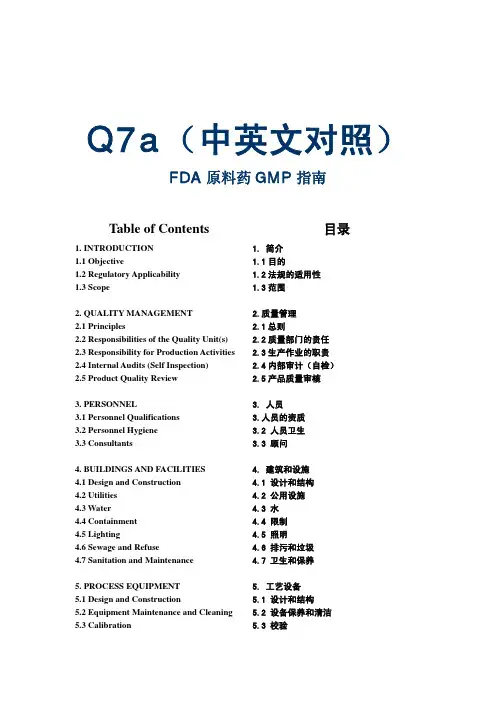
Q7a(中英文对照)FDA原料药GMP指南Table of Contents 目录1. INTRODUCTION 1. 简介1.1 Objective 1.1目的1.2 Regulatory Applicability 1.2法规的适用性1.3 Scope 1.3范围2. QUALITY MANAGEMENT 2.质量管理2.1 Principles 2.1总则2.2 Responsibilities of the Quality Unit(s) 2.2质量部门的责任2.3 Responsibility for Production Activities 2.3生产作业的职责2.4 Internal Audits (Self Inspection) 2.4内部审计(自检)2.5 Product Quality Review 2.5产品质量审核3. PERSONNEL 3. 人员3.1 Personnel Qualifications 3.人员的资质3.2 Personnel Hygiene 3.2 人员卫生3.3 Consultants 3.3 顾问4. BUILDINGS AND FACILITIES 4. 建筑和设施4.1 Design and Construction 4.1 设计和结构4.2 Utilities 4.2 公用设施4.3 Water 4.3 水4.4 Containment 4.4 限制4.5 Lighting 4.5 照明4.6 Sewage and Refuse 4.6 排污和垃圾4.7 Sanitation and Maintenance 4.7 卫生和保养5. PROCESS EQUIPMENT 5. 工艺设备5.1 Design and Construction 5.1 设计和结构5.2 Equipment Maintenance and Cleaning 5.2 设备保养和清洁5.3 Calibration 5.3 校验5.4 Computerized Systems5.4 计算机控制系统6. DOCUMENTATION AND RECORDS6. 文件和记录 6.1 Documentation System andSpecifications6.1 文件系统和质量标准 6.2 Equipment cleaning and Use Record6.2 设备的清洁和使用记录 6.3 Records of Raw Materials,Intermediates, API Labeling and Packaging Materials6.3 原料、中间体、原料药的标签和包装材料的记录 6.4 Master Production Instructions (Master Production and Control Records)6.4 生产工艺规程(主生产和控制记录) 6.5 Batch Production Records (Batch Production and Control Records)6.5 批生产记录(批生产和控制记录) 6.6 Laboratory Control Records6.6 实验室控制记录 6.7 Batch Production Record Review6.7批生产记录审核7. MATERIALS MANAGEMENT7. 物料管理 7.1 General Controls7.1 控制通则 7.2 Receipt and Quarantine7.2接收和待验 7.3 Sampling and Testing of Incoming Production Materials7.3 进厂物料的取样与测试 7.4 Storage7.4储存 7.5 Re-evaluation7.5复验8. PRODUCTION AND IN-PROCESS CONTROLS8. 生产和过程控制 8.1 Production Operations8.1 生产操作 8.2 Time Limits8.2 时限 8.3 In-process Sampling and Controls8.3 工序取样和控制 8.4 Blending Batches of Intermediates or APIs8.4 中间体或原料药的混批 8.5 Contamination Control8.5 污染控制9. PACKAGING AND IDENTIFICATION LABELING OF APIs AND INTERMEDIATES9. 原料药和中间体的包装和贴签 9.1 General9.1 总则 9.2 Packaging Materials9.2 包装材料 9.3 Label Issuance and Control9.3 标签发放与控制 9.4 Packaging and Labeling Operations9.4 包装和贴签操作10. STORAGE AND DISTRIBUTION10.储存和分发 10.1 Warehousing Procedures10.1 入库程序 10.2 Distribution Procedures10.2 分发程序11. LABORATORY CONTROLS11.实验室控制 11.1 General Controls11.1 控制通则 11.2 Testing of Intermediates and APIs11.2 中间体和原料药的测试 11.3 Validation of Analytical Procedures11.3 分析方法的验证 11.4 Certificates of Analysis11.4 分析报告单 11.5 Stability Monitoring of APIs11.5 原料药的稳定性监测 11.6 Expiry and Retest Dating11.6 有效期和复验期 11.7 Reserve/Retention Samples11.7 留样12. V ALIDATION12.验证 12.1 Validation Policy12.1 验证方针 12.2 Validation Documentation12.2 验证文件 12.3 Qualification12.3 确认 12.4 Approaches to Process Validation12.4 工艺验证的方法 12.5 Process Validation Program12.5 工艺验证的程序 12.6 Periodic Review of Validated Systems12.6验证系统的定期审核 12.7 Cleaning Validation12.7 清洗验证 12.8 Validation of Analytical Methods12.8 分析方法的验证13. CHANGE CONTROL13.变更的控制14. REJECTION AND RE-USE OFMATERIALS14.拒收和物料的再利用 14.1 Rejection14.1 拒收 14.2 Reprocessing14.2 返工 14.3 Reworking14.3 重新加工 14.4 Recovery of Materials and Solvents14.4 物料与溶剂的回收 14.5 Returns14.5 退货15. COMPLAINTS AND RECALLS15.投诉与召回16. CONTRACT MANUFACTURERS(INCLUDING LABORATORIES)16.协议生产商(包括实验室)17. AGENTS, BROKERS, TRADERS, DISTRIBUTORS, REPACKERS, ANDRELABELLERS17.代理商、经纪人、贸易商、经销商、重新包装者和重新贴签者 17.1 Applicability17.1适用性 17.2 Traceability of Distributed APIs and Intermediates17.2已分发的原料药和中间体的可追溯性 17.3 Quality Management17.3质量管理 17.4 Repackaging, Relabeling, and Holding of APIs and Intermediates17.4原料药和中间体的重新包装、重新贴签和待检17.5 Stability17.5稳定性 17.6 Transfer of Information17.6 信息的传达 17.7 Handling of Complaints and Recalls17.7 投诉和召回的处理 17.8 Handling of Returns17.8 退货的处理18. Specific Guidance for APIsManufactured by Cell Culture/Fermentation 18. 用细胞繁殖/发酵生产的原料药的特殊指南18.1 General18.1 总则 18.2 Cell Bank Maintenance and Record Keeping18.2细胞库的维护和记录的保存 18.3 Cell Culture/Fermentation18.3细胞繁殖/发酵 18.4 Harvesting, Isolation and Purification18.4收取、分离和精制 18.5 Viral Removal/Inactivation steps18.5 病毒的去除/灭活步骤19. APIs for Use in Clinical Trials19. 用于临床研究的原料药 19.1 General19.1 总则 19.2 Quality19.2 质量 19.3 Equipment and Facilities19.3 设备和设施 19.4 Control of Raw Materials19.4 原料的控制 19.5 Production19.5 生产 19.6 Validation19.6 验证 19.7 Changes19.7 变更 19.8 Laboratory Controls19.8 实验室控制 19.9 Documentation19.9 文件20. Glossary20. 术语Q7a GMP Guidance for APIsQ7a 原料药的GMP 指南1. INTRODUCTION1. 简介 1.1 Objective1.1目的 This document is intended to provide guidance regarding good manufacturing practice (GMP) for the manufacturing of active pharmaceutical ingredients (APIs) under an appropriate system for managing quality. It is also intended to help ensure that APIs meet the quality and purity characteristics that they purport, or are represented, to possess. 本文件旨在为在合适的质量管理体系下制造活性药用成分(以下称原料药)提供有关优良药品生产管理规范(GMP )提供指南。

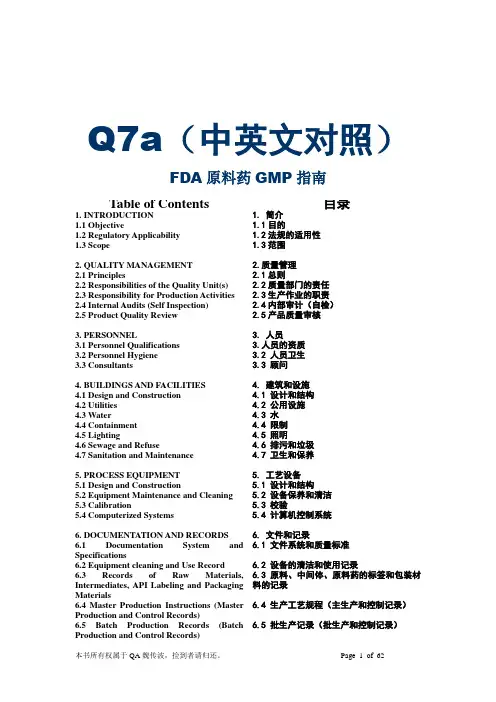
Q7a(中英文对照)FDA原料药GMP指南T able of Contents 目录1. INTRODUCTION 1. 简介1.1 Objective 1.1目的1.2 Regulatory Applicability 1.2法规的适用性1.3 Scope 1.3范围2. QUALITY MANAGEMENT 2.质量管理2.1 Principles 2.1总则2.2 Responsibilities of the Quality Unit(s) 2.2质量部门的责任2.3 Responsibility for Production Activities 2.3生产作业的职责2.4 Internal Audits (Self Inspection) 2.4内部审计(自检)2.5 Product Quality Review 2.5产品质量审核3. PERSONNEL 3. 人员3.1 Personnel Qualifications 3.人员的资质3.2 Personnel Hygiene 3.2 人员卫生3.3 Consultants 3.3 顾问4. BUILDINGS AND FACILITIES 4. 建筑和设施4.1 Design and Construction 4.1 设计和结构4.2 Utilities 4.2 公用设施4.3 Water 4.3 水4.4 Containment 4.4 限制4.5 Lighting 4.5 照明4.6 Sewage and Refuse 4.6 排污和垃圾4.7 Sanitation and Maintenance 4.7 卫生和保养5. PROCESS EQUIPMENT 5. 工艺设备5.1 Design and Construction 5.1 设计和结构5.2 Equipment Maintenance and Cleaning 5.2 设备保养和清洁5.3 Calibration 5.3 校验5.4 Computerized Systems 5.4 计算机控制系统6. DOCUMENTATION AND RECORDS 6. 文件和记录6.1 Documentation System andSpecifications6.1 文件系统和质量标准6.2 Equipment cleaning and Use Record 6.2 设备的清洁和使用记录6.3 Records of Raw Materials, Intermediates, API Labeling and Packaging Materials 6.3 原料、中间体、原料药的标签和包装材料的记录6.4 Master Production Instructions (MasterProduction and Control Records)6.4 生产工艺规程(主生产和控制记录)6.5 Batch Production Records (BatchProduction and Control Records)6.5 批生产记录(批生产和控制记录)6.6 Laboratory Control Records 6.6 实验室控制记录6.7 Batch Production Record Review 6.7批生产记录审核7. MATERIALS MANAGEMENT 7. 物料管理7.1 General Controls 7.1 控制通则7.2 Receipt and Quarantine 7.2接收和待验7.3 进厂物料的取样与测试7.3 Sampling and T esting of IncomingProduction Materials7.4 Storage 7.4储存7.5 Re-evaluation 7.5复验8. 生产和过程控制8. PRODUCTION AND IN-PROCESSCONTROLS8.1 Production Operations 8.1 生产操作8.2 Time Limits 8.2 时限8.3 In-process Sampling and Controls 8.3 工序取样和控制8.4 中间体或原料药的混批8.4 Blending Batches of Intermediates orAPIs8.5 Contamination Control 8.5 污染控制9. 原料药和中间体的包装和贴签9. PACKAGING AND IDENTIFICATIONLABELING OF APIs ANDINTERMEDIATES9.1 General 9.1 总则9.2 Packaging Materials 9.2 包装材料9.3 Label Issuance and Control 9.3 标签发放与控制9.4 Packaging and Labeling Operations 9.4 包装和贴签操作10. STORAGE AND DISTRIBUTION 10.储存和分发10.1 Warehousing Procedures 10.1 入库程序10.2 Distribution Procedures 10.2 分发程序11. LABORATORY CONTROLS 11.实验室控制11.1 General Controls 11.1 控制通则11.2 T esting of Intermediates and APIs 11.2 中间体和原料药的测试11.3 Validation of Analytical Procedures 11.3 分析方法的验证11.4 Certificates of Analysis 11.4 分析报告单11.5 Stability Monitoring of APIs 11.5 原料药的稳定性监测11.6 Expiry and Retest Dating 11.6 有效期和复验期11.7 Reserve/Retention Samples 11.7 留样12. V ALIDATION 12.验证12.1 Validation Policy 12.1 验证方针12.2 Validation Documentation 12.2 验证文件12.3 Qualification 12.3 确认12.4 Approaches to Process Validation 12.4 工艺验证的方法12.5 Process Validation Program 12.5 工艺验证的程序12.6 Periodic Review of Validated Systems 12.6验证系统的定期审核12.7 Cleaning Validation 12.7 清洗验证12.8 Validation of Analytical Methods 12.8 分析方法的验证13. CHANGE CONTROL 13.变更的控制14. REJECTION AND RE-USE OF14.拒收和物料的再利用MATERIALS14.1 Rejection 14.1 拒收14.2 Reprocessing 14.2 返工14.3 Reworking 14.3 重新加工14.4 Recovery of Materials and Solvents 14.4 物料与溶剂的回收14.5 Returns 14.5 退货15. COMPLAINTS AND RECALLS 15.投诉与召回16. CONTRACT MANUFACTURERS(INCLUDING LABORATORIES)16.协议生产商(包括实验室)17. AGENTS, BROKERS, TRADERS, DISTRIBUTORS, REPACKERS, AND RELABELLERS 17.代理商、经纪人、贸易商、经销商、重新包装者和重新贴签者17.1 Applicability 17.1适用性17.2 T raceability of Distributed APIs andIntermediates17.2已分发的原料药和中间体的可追溯性17.3 Quality Management 17.3质量管理17.4 Repackaging, Relabeling, and Holding of APIs and Intermediates 17.4原料药和中间体的重新包装、重新贴签和待检17.5 Stability 17.5稳定性17.6 T ransfer of Information 17.6 信息的传达17.7 Handling of Complaints and Recalls 17.7 投诉和召回的处理17.8 Handling of Returns 17.8 退货的处理18. Specific Guidance for APIs Manufactured by Cell Culture/Fermentation 18. 用细胞繁殖/发酵生产的原料药的特殊指南18.1 General 18.1 总则18.2 Cell Bank Maintenance and RecordKeeping18.2细胞库的维护和记录的保存18.3 Cell Culture/Fermentation 18.3细胞繁殖/发酵18.4 Harvesting, Isolation and Purification 18.4收取、分离和精制18.5 Viral Removal/Inactivation steps 18.5 病毒的去除/灭活步骤19.APIs for Use in Clinical Trials 19.用于临床研究的原料药19.1 General 19.1 总则19.2 Quality 19.2 质量19.3 Equipment and Facilities 19.3 设备和设施19.4 Control of Raw Materials 19.4 原料的控制19.5 Production 19.5 生产19.6 Validation 19.6 验证19.7 Changes 19.7 变更19.8 Laboratory Controls 19.8 实验室控制19.9 Documentation 19.9 文件20. Glossary 20. 术语Q7a GMP Guidance for APIs Q7a原料药的GMP指南1. INTRODUCTION 1. 简介1.1 Objective 1.1目的This document is intended to provide guidance regarding good manufacturing practice (GMP) for the manufacturing of active pharmaceutical ingredients (APIs) under an appropriate system for managing quality. It is also intended to help ensure that APIs meet the quality and purity characteristics that they purport, or are represented, to possess. 本文件旨在为在合适的质量管理体系下制造活性药用成分(以下称原料药)提供有关优良药品生产管理规范(GMP)提供指南。
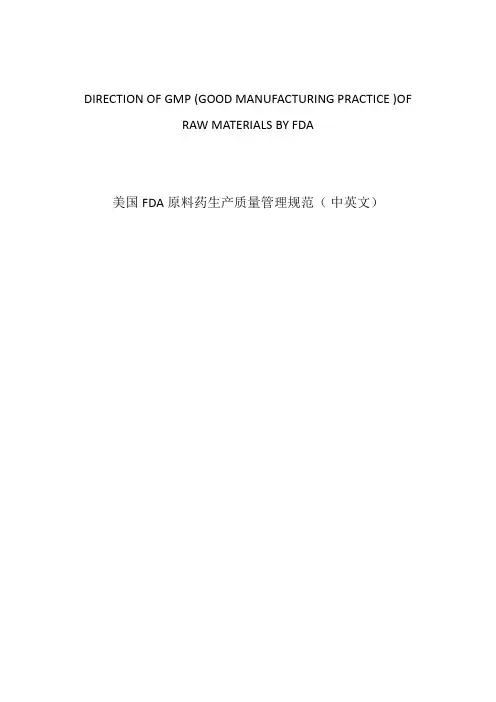
DIRECTION OF GMP (GOOD MANUFACTURING PRACTICE )OFRAW MATERIALS BY FDA美国FDA原料药生产质量管理规范(中英文)Table of Contents 目录1. INTRODUCTION 简介1.1 Objective 目的1.2 Regulatory Applicability法规的适用性1.3 Scope 范围2. QUALITY MANAGEMENT .质量管理2.1 Principles 总则2.2 Responsibilities of the Quality Unit(s) 质量部门的责任2.3 Responsibility for Production Activities 生产作业的职责2.4 Internal Audits (Self Inspection) 内部审计(自检)2.5 Product Quality Review 产品质量审核3. PERSONNEL 人员3.1 Personnel Qualifications 人员的资质3.2 Personnel Hygiene 人员卫生3.3 Consultants 顾问4. BUILDINGS AND FACILITIES 建筑和设施4.1 Design and Construction 设计和结构4.2 Utilities 公用设施4.3 Water 水4.4 Containment 限制4.5 Lighting 照明4.6 Sewage and Refuse 排污和垃圾4.7 Sanitation and Maintenance 卫生和保养5. PROCESS EQUIPMENT 工艺设备5.1 Design and Construction 设计和结构5.2 Equipment Maintenance and Cleaning 设备保养和清洁5.3 Calibration. 校验5.4 Computerized Systems 计算机控制系统6. DOCUMENTATION AND RECORDS 文件和记录6.1 Documentation System and Specifications 文件系统和质量标准6.2 Equipment cleaning and Use Record 设备的清洁和使用记录6.3 Records of Raw Materials, Intermediates, API Labeling and Packaging Materials 原料、中间体、原料药的标签和包装材料的记录6.4 Master Production Instructions (Master Production and Control Records)生产工艺规程(主生产和控制记录)6.5 Batch Production Records (Batch Production and Control Records)批生产记录(批生产和控制记录)6.6 Laboratory Control Records 实验室控制记录6.7 Batch Production Record Review 批生产记录审核7. MATERIALS MANAGEMENT 物料管理7.1 General Controls 控制通则7.2 Receipt and Quarantine 接收和待验7.3 Sampling and Testing of Incoming Production Materials 进厂物料的取样与测试7.4 Storage 储存7.5 Re-evaluation 复验8. PRODUCTION AND IN-PROCESS CONTROLS 生产和过程控制8.1 Production Operations 生产操作8.2 Time Limits 时限8.3 In-process Sampling and Controls 工序取样和控制8.4 Blending Batches of Intermediates or APIs 中间体或原料药的混批8.5 Contamination Control 污染控制9. PACKAGING AND IDENTIFICATION LABELING OF APIs AND INTERMEDIATES原料药和中间体的包装和贴签9.1 General 总则9.2 Packaging Materials 包装材料9.3 Label Issuance and Control 标签发放与控制9.4 Packaging and Labeling Operations 包装和贴签操作10. STORAGE AND DISTRIBUTION.储存和分发10.1 Warehousing Procedures 入库程序10.2 Distribution Procedures 分发程序11. LABORATORY CONTROLS 实验室控制11.1 General Controls 控制通则11.2 Testing of Intermediates and APIs 中间体和原料药的测试11.3 Validation of Analytical Procedures 分析方法的验证11.4 Certificates of Analysis分析报告单11.5 Stability Monitoring of APIs 原料药的稳定性监测11.6 Expiry and Retest Dating 有效期和复验期11.7 Reserve/Retention Samples 留样12. VALIDATION .验证12.1 Validation Policy 验证方针12.2 Validation Documentation 验证文件12.3 Qualification 确认12.4 Approaches to Process Validation 工艺验证的方法12.5 Process Validation Program 工艺验证的程序12.6 Periodic Review of Validated Systems 验证系统的定期审核12.7 Cleaning Validation 清洗验证12.8 Validation of Analytical Methods 分析方法的验证13. CHANGE CONTROL 变更的控制14. REJECTION AND RE-USE OF MATERIALS.拒收和物料的再利用14.1 Rejection 拒收14.2 Reprocessing 返工14.3 Reworking 重新加工14.4 Recovery of Materials and Solvents 物料与溶剂的回收14.5 Returns 退货15. COMPLAINTS AND RECALLS 投诉与召回16. CONTRACT MANUFACTURERS (INCLUDING LABORATORIES)协议生产商(包括实验室)17. AGENTS, BROKERS, TRADERS, DISTRIBUTORS, REPACKERS, AND RELABELLERS 代理商、经纪人、贸易商、经销商、重新包装者和重新贴签者17.1 Applicability 适用性17.2 Traceability of Distributed APIs and Intermediates已分发的原料药和中间体的可追溯性17.3 Quality Management 质量管理17.4 Repackaging, Relabeling, and Holding of APIs and Intermediates原料药和中间体的重新包装、重新贴签和待检17.5 Stability 稳定性17.6 Transfer of Information 信息的传达17.7 Handling of Complaints and Recalls 投诉和召回的处理17.8 Handling of Returns 退货的处理18. Specific Guidance for APIs Manufactured by Cell Culture/Fermentation用细胞繁殖/发酵生产的原料药的特殊指南18.1 General 总则18.2 Cell Bank Maintenance and Record Keeping 细胞库的维护和记录的保存18.3 Cell Culture/Fermentation 细胞繁殖/发酵18.4 Harvesting, Isolation and Purification 收取、分离和精制18.5 Viral Removal/Inactivation steps 病毒的去除/灭活步骤19. APIs for Use in Clinical Trials 用于临床研究的原料药19.1 General 总则19.2 Quality 质量19.3 Equipment and Facilities设备和设施19.4 Control of Raw Materials 原料的控制19.5 Production 生产19.6 Validation 验证19.7 Changes 变更19.8 Laboratory Controls 实验室控制19.9 Documentation 文件20. Glossary 术语1. INTRODUCTION 1. 简介1.1 Objective 1.1目的This document is intended to provide guidance regarding good manufacturing practice (GMP) for the manufacturing of active pharmaceutical ingredients (APIs) under an appropriate system for managing quality. It is also intended to help ensure that APIs meet the quality and purity characteristics that they purport, or are represented, to possess.本文件旨在为在合适的质量管理体系下制造活性药用成分(以下称原料药)提供有关优良药品生产管理规范(GMP)提供指南。
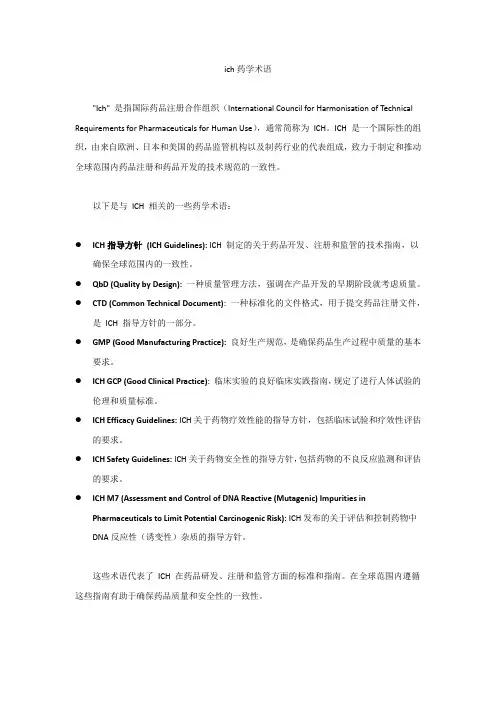
ich药学术语"Ich" 是指国际药品注册合作组织(International Council for Harmonisation of Technical Requirements for Pharmaceuticals for Human Use),通常简称为ICH。
ICH 是一个国际性的组织,由来自欧洲、日本和美国的药品监管机构以及制药行业的代表组成,致力于制定和推动全球范围内药品注册和药品开发的技术规范的一致性。
以下是与ICH 相关的一些药学术语:●ICH指导方针(ICH Guidelines): ICH 制定的关于药品开发、注册和监管的技术指南,以确保全球范围内的一致性。
●QbD (Quality by Design):一种质量管理方法,强调在产品开发的早期阶段就考虑质量。
●CTD (Common Technical Document): 一种标准化的文件格式,用于提交药品注册文件,是ICH 指导方针的一部分。
●GMP (Good Manufacturing Practice):良好生产规范,是确保药品生产过程中质量的基本要求。
●ICH GCP (Good Clinical Practice): 临床实验的良好临床实践指南,规定了进行人体试验的伦理和质量标准。
●ICH Efficacy Guidelines: ICH关于药物疗效性能的指导方针,包括临床试验和疗效性评估的要求。
●ICH Safety Guidelines: ICH关于药物安全性的指导方针,包括药物的不良反应监测和评估的要求。
●ICH M7 (Assessment and Control of DNA Reactive (Mutagenic) Impurities inPharmaceuticals to Limit Potential Carcinogenic Risk): ICH发布的关于评估和控制药物中DNA反应性(诱变性)杂质的指导方针。
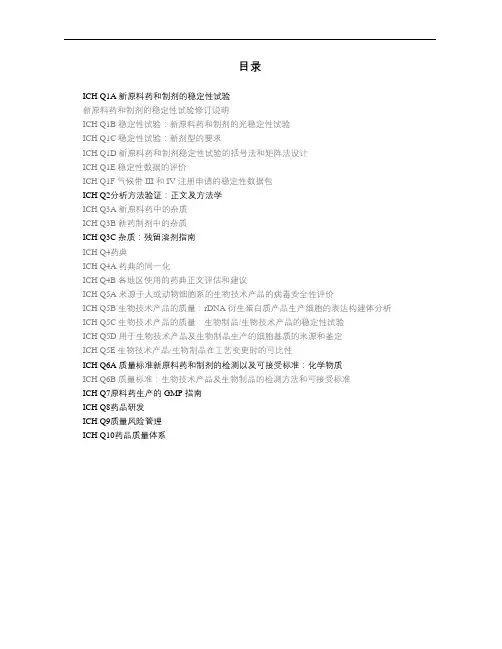
目录ICH Q1A新原料药和制剂的稳定性试验新原料药和制剂的稳定性试验修订说明ICH Q1B稳定性试验:新原料药和制剂的光稳定性试验ICH Q1C稳定性试验:新剂型的要求ICH Q1D新原料药和制剂稳定性试验的括号法和矩阵法设计ICH Q1E稳定性数据的评价ICH Q1F气候带III和IV注册申请的稳定性数据包ICH Q2分析方法验证:正文及方法学ICH Q3A新原料药中的杂质ICH Q3B新药制剂中的杂质ICH Q3C杂质:残留溶剂指南ICH Q4药典ICH Q4A药典的同一化ICH Q4B各地区使用的药典正文评估和建议ICH Q5A来源于人或动物细胞系的生物技术产品的病毒安全性评价ICH Q5B生物技术产品的质量:rDNA衍生蛋白质产品生产细胞的表达构建体分析ICH Q5C生物技术产品的质量:生物制品/生物技术产品的稳定性试验ICH Q5D用于生物技术产品及生物制品生产的细胞基质的来源和鉴定ICH Q5E生物技术产品/生物制品在工艺变更时的可比性ICH Q6A质量标准新原料药和制剂的检测以及可接受标准:化学物质ICH Q6B质量标准:生物技术产品及生物制品的检测方法和可接受标准ICH Q7原料药生产的GMP指南ICH Q8药品研发ICH Q9质量风险管理ICH Q10药品质量体系ICH指导原则新药物与新产品稳定性研究Q1A(R2)2003.2.6现行第4版新药物与新产品稳定性研究Q1A(R)修正说明本说明意在指出引入ICH Q1F“国际气候带Ⅲ和Ⅳ地区注册申报稳定性数据”后Q1A(R)所作修正,修正如下:1.下列章节中,中间条件环境由30℃±2℃/60%RH±5%修正为30℃±2℃/65%RH±5%1. 2.1.7.1 原料药-储存条件-通常情况2. 2.2.7.1 制剂-储存条件-通常情况3. 2.2.7.3 半透过性容器包装的制剂4. 3 术语-“中间条件检测”2.下列章节中,长期实验储存条件30℃±2℃/65%RH±5%可以替换25℃±2℃/60%RH±5%1. 2.1.7.1 原料药-储存条件-通常情况2. 2.2.7.1 制剂-储存条件-通常情况3. 长期实验储存条件增加30℃±2℃/35%RH±5%作为25℃±2℃/40%RH±5%的可替换条件,其相应的失水率考察举例如下列章节中:1. 2.2.7.3半透过性容器包装的制剂中间条件储存环境可以由30℃±2℃/60%RH±5%转为30℃±2℃/65%RH±5%,储存条件及其转换日期应在注册申请文件中详细标注。
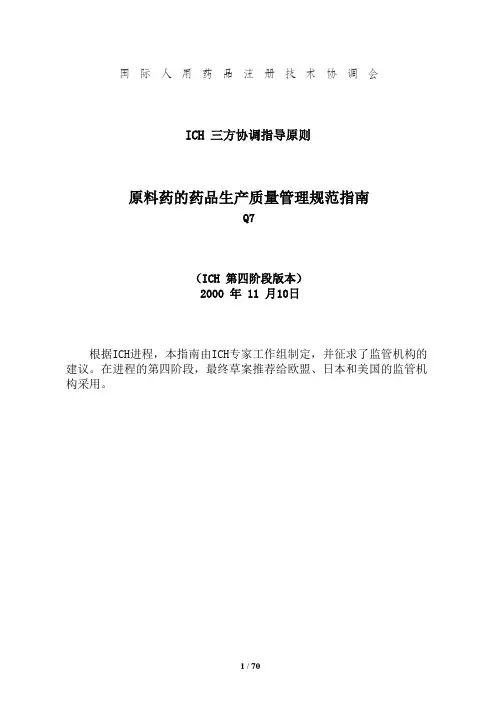
国际人用药品注册技术协调会ICH 三方协调指导原则原料药的药品生产质量管理规范指南Q7(ICH 第四阶段版本)2000 年 11 月10日根据ICH进程,本指南由ICH专家工作组制定,并征求了监管机构的建议。
在进程的第四阶段,最终草案推荐给欧盟、日本和美国的监管机构采用。
Q7现行第四阶段版本原料药的药品生产质量管理规范指南ICH 指导委员会在2000年11月10日完成了ICH进程的第四阶段,该指南推荐给ICH三方的监管机构采用。
目录1总则 (6)1.1目的 (6)1.2法规适用性 (6)1.3范围 (6)2质量管理 (9)2.1原则 (9)2.2质量管理部门的职责 (10)2.3生产部门的职责 (11)2.4内部审计(自检) (12)2.5产品质量回顾 (12)3人员 (13)3.1人员资质 (13)3.2人员卫生 (13)3.3顾问 (14)4厂房和设施 (14)4.1设计和建造 (14)4.2公用设施 (15)4.3水 (16)4.4控制 (17)4.5照明 (17)4.6污水和污物 (17)4.7卫生和维护 (17)5工艺设备 (18)5.1设计和构造 (18)5.2设备的维护和清洁 (19)5.3校准 (20)5.4计算机化系统 (20)6文件和记录 (21)6.1文件系统和质量标准 (21)6.2设备的清洁和使用记录 (22)6.3原料、中间体、原料药标签和包装材料的记录 (23)6.4工艺规程(主生产和检验记录) (23)6.5批生产记录(批生产和检验记录) (24)6.6检验记录 (26)6.7批生产记录审核 (27)7物料管理 (27)7.1原则 (27)7.2接收和待验 (28)7.3进厂物料的取样和检验 (29)7.4贮存 (30)7.5再评估 (30)8生产和过程控制 (30)8.1生产操作 (30)8.2时限 (32)8.3中间控制和取样 (32)8.4中间体或原料药的混合 (33)8.5污染的控制 (34)9原料药和中间体的包装和贴签 (34)9.1原则 (34)9.2包装材料 (35)9.3标签的发放和控制 (35)9.4包装和贴签操作 (36)10贮存和发运 (36)10.1入库规程 (36)10.2发运规程 (37)11实验室管理 (37)11.1基本原则 (37)11.2中间体和原料药的检测 (39)11.3分析方法的验证—参见第12节 (39)11.4检验报告 (39)11.5原料药稳定性考察 (40)11.6有效期和复验期 (41)11.7留样 (42)12验证 (42)12.1验证方针 (42)12.2验证文件 (43)12.3确认 (43)12.4工艺验证的方式 (44)12.5工艺验证程序 (45)12.6已验证系统的定期审核 (45)12.7清洁验证 (46)12.8分析方法的验证 (47)13.变更控制 (48)14物料的拒绝放行和再使用 (49)14.1拒绝放行 (49)14.2返工 (49)14.3重新加工 (49)14.4物料和溶剂的回收 (50)14.5退货 (50)15投诉和召回 (51)16受托生产商(包括实验室) (52)17.代理商、中间商、贸易商、经销商、分包装商和重新贴签方 (53)17.1适用性 (53)17.2已发运的原料药和中间体的可追溯性 (53)17.3质量管理 (54)17.4中间体和原料药的分包装、重新贴签和存放 (54)17.5稳定性 (54)17.6信息传递 (54)17.7投诉和召回的处理 (55)17.8退货处理 (55)18细胞培养/发酵生产原料药专用指南 (55)18.1通则 (55)18.2细胞库的维护和记录保存 (57)18.3细胞培养/发酵 (58)18.4收获、分离和纯化 (59)18.5病毒去除/灭活步骤 (60)19临床试验用原料药 (60)19.1通则 (60)19.2质量 (61)19.3设备和设施 (61)19.4原料的控制 (62)19.5生产 (62)19.6验证 (62)19.7变更 (63)19.8实验室控制 (63)19.9文件 (63)20.术语 (64)原料药的药品生产质量管理规范指南1总则1.1目的本指南旨在适宜的质量管理体系下为原料药(英文简称APIs)的生产提供药品生产质量管理规范(GMP)指导。
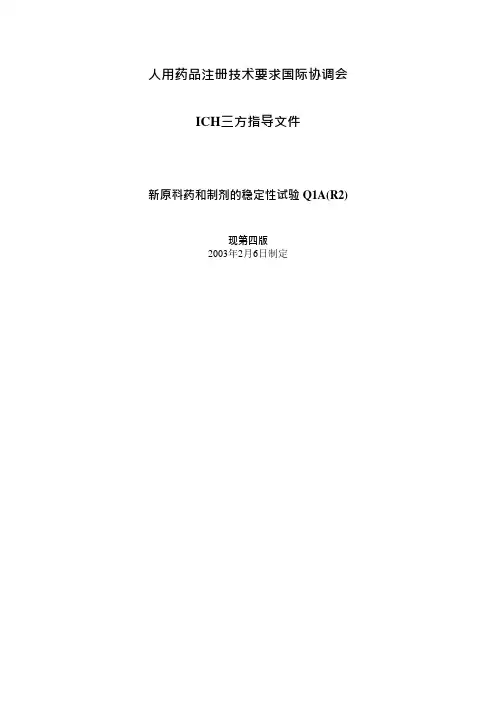
人用药品注册技术要求国际协调会ICH三方指导文件新原料药和制剂的稳定性试验Q1A(R2)现第四版2003年2月6日制定Q1A(R2) 文件历程现第四版新原料药和制剂的稳定性试验Q1A(R)修订说明本修订的目的为了明确由于采用了ICH Q1F“在气候带Ⅲ和Ⅳ注册申请的稳定性数据包”而使Q1A(R)而产生的变更。
这些变更如下:1.在下面章节中将中间储存条件从温度30℃±2℃/相对湿度60%±5%修改为温度30℃±2℃/相对湿度65%±5%:2.1.7.1 原料药-储存条件-一般情况2.2.7.1 制剂-储存条件-一般情况2.2.7.3 在半渗透性容器中包装的制剂3 术语-“中间试验”2.在下面章节中可以使用温度30℃±2℃/相对湿度65%±5%替代温度25℃±2℃/相对湿度60%±5%作为长期稳定性试验的条件:2.1.7.1 原料药-储存条件-一般情况2.2.7.1 制剂-储存条件-一般情况3. 在温度25℃±2℃/相对湿度40%±5%的基础上增加了温度30℃±2℃/相对湿度35%±5%作为长期稳定性试验条件,并且在后面的章节中包括了失水比率相关举例的相关情况:2.2.7.3 在半透性容器中包装的制剂在试验阶段中间将中间将储存条件从温度30℃±2℃/相对湿度60%±5%调整为温度30℃±2℃/相对湿度65%±5%是可以的,但相应的储存条件和调整的日期要在注册申报资料中清楚地说明和列出。
如果适用的话建议ICH三方在公布和执行此修订指南三年后,注册申请资料中完整的试验能够包含在中间储存条件,即温度30℃±2℃/相对湿度65%±5%下的实验资料。
S TABILITY T ESTING OF N EWD RUG S UBSTANCES ANDP RODUCTS1.INTRODUCTION1.1.Objectives of the GuidelineThe following guideline is a revised version of the ICH Q1A guideline and defines the stability data package for a new drug substance or drug product that is sufficient for a registration application within the three regions of the EC, Japan, and the United States. It does not seek necessarily to cover the testing for registration in or export to other areas of the world.The guideline seeks to exemplify the core stability data package for new drug substances and products, but leaves sufficient flexibility to encompass the variety of different practical situations that may be encountered due to specific scientific considerations and characteristics of the materials being evaluated. Alternative approaches can be used when there are scientifically justifiable reasons.1.2.Scope of the GuidelineThe guideline addresses the information to be submitted in registration applications for new molecular entities and associated drug products. This guideline does not currently seek to cover the information to be submitted for abbreviated or abridged applications, variations, clinical trial applications, etc.新原料药和制剂稳定性试验1.导言1.1.目的下述的指导原则是ICH Q1A 的修订版本,并且它为新原料药和制剂在欧洲、日本、美国三个地区注册所需要的稳定性资料做出规定要求。
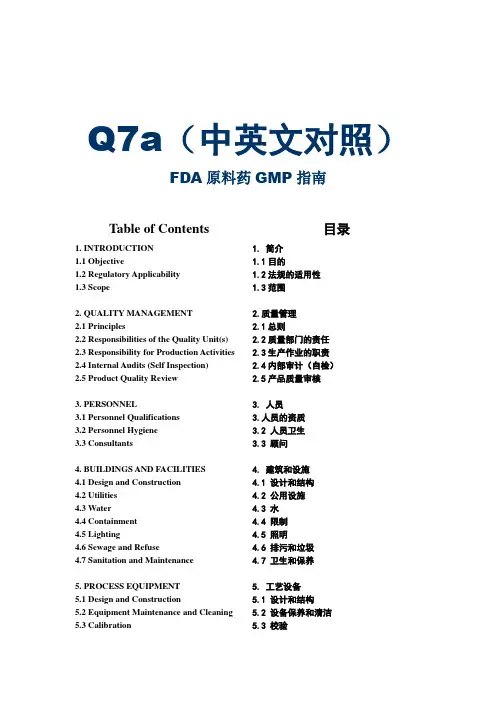
Q7a(中英文对照)FDA原料药GMP指南Table of Contents 目录1. INTRODUCTION 1. 简介1.1 Objective 1.1目的1.2 Regulatory Applicability 1.2法规的适用性1.3 Scope 1.3范围2. QUALITY MANAGEMENT 2.质量管理2.1 Principles 2.1总则2.2 Responsibilities of the Quality Unit(s) 2.2质量部门的责任2.3 Responsibility for Production Activities 2.3生产作业的职责2.4 Internal Audits (Self Inspection) 2.4内部审计(自检)2.5 Product Quality Review 2.5产品质量审核3. PERSONNEL 3. 人员3.1 Personnel Qualifications 3.人员的资质3.2 Personnel Hygiene 3.2 人员卫生3.3 Consultants 3.3 顾问4. BUILDINGS AND FACILITIES 4. 建筑和设施4.1 Design and Construction 4.1 设计和结构4.2 Utilities 4.2 公用设施4.3 Water 4.3 水4.4 Containment 4.4 限制4.5 Lighting 4.5 照明4.6 Sewage and Refuse 4.6 排污和垃圾4.7 Sanitation and Maintenance 4.7 卫生和保养5. PROCESS EQUIPMENT 5. 工艺设备5.1 Design and Construction 5.1 设计和结构5.2 Equipment Maintenance and Cleaning 5.2 设备保养和清洁5.3 Calibration 5.3 校验5.4 Computerized Systems 5.4 计算机控制系统6. DOCUMENTATION AND RECORDS 6. 文件和记录6.1 Documentation System andSpecifications6.1 文件系统和质量标准6.2 Equipment cleaning and Use Record 6.2 设备的清洁和使用记录6.3 Records of Raw Materials, Intermediates, API Labeling and Packaging Materials 6.3 原料、中间体、原料药的标签和包装材料的记录6.4 Master Production Instructions (MasterProduction and Control Records)6.4 生产工艺规程(主生产和控制记录)6.5 Batch Production Records (BatchProduction and Control Records)6.5 批生产记录(批生产和控制记录)6.6 Laboratory Control Records 6.6 实验室控制记录6.7 Batch Production Record Review 6.7批生产记录审核7. MATERIALS MANAGEMENT 7. 物料管理7.1 General Controls 7.1 控制通则7.2 Receipt and Quarantine 7.2接收和待验7.3 Sampling and Testing of IncomingProduction Materials7.3 进厂物料的取样与测试7.4 Storage 7.4储存7.5 Re-evaluation 7.5复验8. PRODUCTION AND IN-PROCESSCONTROLS8. 生产和过程控制8.1 Production Operations 8.1 生产操作8.2 Time Limits 8.2 时限8.3 In-process Sampling and Controls 8.3 工序取样和控制8.4 Blending Batches of Intermediates orAPIs8.4 中间体或原料药的混批8.5 Contamination Control 8.5 污染控制9. PACKAGING AND IDENTIFICATIONLABELING OF APIs ANDINTERMEDIATES9. 原料药和中间体的包装和贴签9.1 General 9.1 总则9.2 Packaging Materials 9.2 包装材料9.3 Label Issuance and Control 9.3 标签发放与控制9.4 Packaging and Labeling Operations 9.4 包装和贴签操作10. STORAGE AND DISTRIBUTION 10.储存和分发10.1 Warehousing Procedures 10.1 入库程序10.2 Distribution Procedures 10.2 分发程序11. LABORATORY CONTROLS 11.实验室控制11.1 General Controls 11.1 控制通则11.2 Testing of Intermediates and APIs 11.2 中间体和原料药的测试11.3 Validation of Analytical Procedures 11.3 分析方法的验证11.4 Certificates of Analysis 11.4 分析报告单11.5 Stability Monitoring of APIs 11.5 原料药的稳定性监测11.6 Expiry and Retest Dating 11.6 有效期和复验期11.7 Reserve/Retention Samples 11.7 留样12. V ALIDATION 12.验证12.1 Validation Policy 12.1 验证方针12.2 Validation Documentation 12.2 验证文件12.3 Qualification 12.3 确认12.4 Approaches to Process Validation 12.4 工艺验证的方法12.5 Process Validation Program 12.5 工艺验证的程序12.6 Periodic Review of Validated Systems 12.6验证系统的定期审核12.7 Cleaning Validation 12.7 清洗验证12.8 Validation of Analytical Methods 12.8 分析方法的验证13. CHANGE CONTROL 13.变更的控制14. REJECTION AND RE-USE OFMATERIALS14.拒收和物料的再利用14.1 Rejection 14.1 拒收14.2 Reprocessing 14.2 返工14.3 Reworking 14.3 重新加工14.4 Recovery of Materials and Solvents 14.4 物料与溶剂的回收14.5 Returns 14.5 退货15. COMPLAINTS AND RECALLS 15.投诉与召回16. CONTRACT MANUFACTURERS(INCLUDING LABORATORIES)16.协议生产商(包括实验室)17. AGENTS, BROKERS, TRADERS, DISTRIBUTORS, REPACKERS, AND RELABELLERS 17.代理商、经纪人、贸易商、经销商、重新包装者和重新贴签者17.1 Applicability 17.1适用性17.2 Traceability of Distributed APIs andIntermediates17.2已分发的原料药和中间体的可追溯性17.3 Quality Management 17.3质量管理17.4 Repackaging, Relabeling, and Holding of APIs and Intermediates 17.4原料药和中间体的重新包装、重新贴签和待检17.5 Stability 17.5稳定性17.6 Transfer of Information 17.6 信息的传达17.7 Handling of Complaints and Recalls 17.7 投诉和召回的处理17.8 Handling of Returns 17.8 退货的处理18. Specific Guidance for APIs Manufactured by Cell Culture/Fermentation 18. 用细胞繁殖/发酵生产的原料药的特殊指南18.1 General 18.1 总则18.2 Cell Bank Maintenance and RecordKeeping18.2细胞库的维护和记录的保存18.3 Cell Culture/Fermentation 18.3细胞繁殖/发酵18.4 Harvesting, Isolation and Purification 18.4收取、分离和精制18.5 Viral Removal/Inactivation steps 18.5 病毒的去除/灭活步骤19.APIs for Use in Clinical Trials 19.用于临床研究的原料药19.1 General 19.1 总则19.2 Quality 19.2 质量19.3 Equipment and Facilities 19.3 设备和设施19.4 Control of Raw Materials 19.4 原料的控制19.5 Production 19.5 生产19.6 Validation 19.6 验证19.7 Changes 19.7 变更19.8 Laboratory Controls 19.8 实验室控制19.9 Documentation 19.9 文件20. Glossary 20. 术语Q7a GMP Guidance for APIs Q7a原料药的GMP指南1. INTRODUCTION 1. 简介1.1 Objective 1.1目的This document is intended to provide guidance regarding good manufacturing practice (GMP) for the manufacturing of active pharmaceutical ingredients (APIs) under an appropriate system for managing quality. It is also intended to help ensure that APIs meet the quality and purity characteristics that they purport, or are represented, to possess. 本文件旨在为在合适的质量管理体系下制造活性药用成分(以下称原料药)提供有关优良药品生产管理规范(GMP)提供指南。
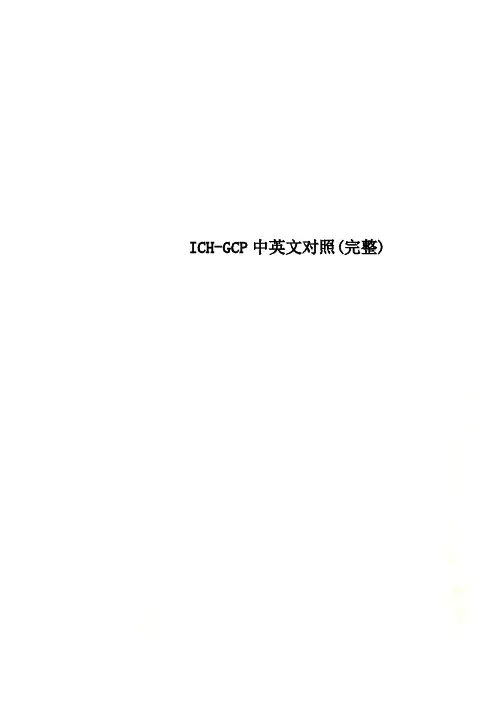
ICH-GCP中英文对照(完整)ICH 三方协调指导原则 E6 ICH GCP指导原则INTRODUCTION前言Good Clinical Practice (GCP) is an international ethical and scientific quality standard for designing, conducting, recording and reporting trials that involve the participation of human subjects. Compliance with this standard provides public assurance that the rights, safety and well-being of trial subjects are protected, consistent with the principles that have their origin in the Declaration of Helsinki, and that the clinical trial data are credible.临床试验管理规范(GCP)是设计、实施、记录和报告设计人类对象参加的试验国际性伦理和科学质量标准。
遵循这一标准为保护对象的权利、安全性和健康,为与源于赫尔辛基宣言的原则保持一致以及临床试验数据的可信性提供了公众保证。
The objective of this ICH GCP Guideline is to provide a unified standard for the European Union (EU), Japan and the United States to facilitate the mutual acceptance of clinical data by theregulatory authorities in these jurisdictions. ICH-GCP指导原则的目的是为欧盟、日本和美国提供统一的标准,以促进这些管理当局在其权限内相互接受临床数据。
Q7a(中英文对照)FDA原料药GMP指南Table of Contents 目录1. INTRODUCTION 1. 简介1.1 Objective 1.1目的1.2 Regulatory Applicability 1.2法规的适用性1.3 Scope 1.3范围2. QUALITY MANAGEMENT 2.质量管理2.1 Principles 2.1总则2.2 Responsibilities of the Quality Unit(s) 2.2质量部门的责任2.3 Responsibility for Production Activities 2.3生产作业的职责2.4 Internal Audits (Self Inspection) 2.4内部审计(自检)2.5 Product Quality Review 2.5产品质量审核3. PERSONNEL 3. 人员3.1 Personnel Qualifications 3.人员的资质3.2 Personnel Hygiene 3.2 人员卫生3.3 Consultants 3.3 顾问4. BUILDINGS AND FACILITIES 4. 建筑和设施4.1 Design and Construction 4.1 设计和结构4.2 Utilities 4.2 公用设施4.3 Water 4.3 水4.4 Containment 4.4 限制4.5 Lighting 4.5 照明4.6 Sewage and Refuse 4.6 排污和垃圾4.7 Sanitation and Maintenance 4.7 卫生和保养5. PROCESS EQUIPMENT 5. 工艺设备5.1 Design and Construction 5.1 设计和结构5.2 Equipment Maintenance and Cleaning 5.2 设备保养和清洁5.3 Calibration 5.3 校验5.4 Computerized Systems 5.4 计算机控制系统6. DOCUMENTATION AND RECORDS 6. 文件和记录6.1 Documentation System and Specifications 6.1 文件系统和质量标准6.2 Equipment cleaning and Use Record 6.2 设备的清洁和使用记录6.3 Records of Raw Materials, Intermediates, API Labeling and Packaging Materials 6.3 原料、中间体、原料药的标签和包装材料的记录6.4 Master Production Instructions (MasterProduction and Control Records)6.4 生产工艺规程(主生产和控制记录)6.5 Batch Production Records (Batch Productionand Control Records)6.5 批生产记录(批生产和控制记录)6.6 Laboratory Control Records 6.6 实验室控制记录6.7 Batch Production Record Review 6.7批生产记录审核7. MATERIALS MANAGEMENT 7. 物料管理7.1 General Controls 7.1 控制通则7.2 Receipt and Quarantine 7.2接收和待验7.3 进厂物料的取样与测试7.3 Sampling and Testing of Incoming ProductionMaterials7.4 Storage 7.4储存7.5 Re-evaluation 7.5复验8. 生产和过程控制8. PRODUCTION AND IN-PROCESSCONTROLS8.1 Production Operations 8.1 生产操作8.2 Time Limits 8.2 时限8.3 In-process Sampling and Controls 8.3 工序取样和控制8.4 Blending Batches of Intermediates or APIs 8.4 中间体或原料药的混批8.5 Contamination Control 8.5 污染控制9. PACKAGING AND IDENTIFICATION9. 原料药和中间体的包装和贴签LABELING OF APIs AND INTERMEDIATES9.1 General 9.1 总则9.2 Packaging Materials 9.2 包装材料9.3 Label Issuance and Control 9.3 标签发放与控制9.4 Packaging and Labeling Operations 9.4 包装和贴签操作10. STORAGE AND DISTRIBUTION 10.储存和分发10.1 Warehousing Procedures 10.1 入库程序10.2 Distribution Procedures 10.2 分发程序11. LABORATORY CONTROLS 11.实验室控制11.1 General Controls 11.1 控制通则11.2 Testing of Intermediates and APIs 11.2 中间体和原料药的测试11.3 Validation of Analytical Procedures 11.3 分析方法的验证11.4 Certificates of Analysis 11.4 分析报告单11.5 Stability Monitoring of APIs 11.5 原料药的稳定性监测11.6 Expiry and Retest Dating 11.6 有效期和复验期11.7 Reserve/Retention Samples 11.7 留样12. V ALIDATION 12.验证12.1 Validation Policy 12.1 验证方针12.2 Validation Documentation 12.2 验证文件12.3 Qualification 12.3 确认12.4 Approaches to Process Validation 12.4 工艺验证的方法12.5 Process Validation Program 12.5 工艺验证的程序12.6 Periodic Review of Validated Systems 12.6验证系统的定期审核12.7 Cleaning Validation 12.7 清洗验证12.8 Validation of Analytical Methods 12.8 分析方法的验证13. CHANGE CONTROL 13.变更的控制14. REJECTION AND RE-USE OF MATERIALS 14.拒收和物料的再利用14.1 Rejection 14.1 拒收14.2 Reprocessing 14.2 返工14.3 Reworking 14.3 重新加工14.4 Recovery of Materials and Solvents 14.4 物料与溶剂的回收14.5 Returns 14.5 退货15. COMPLAINTS AND RECALLS 15.投诉与召回16. CONTRACT MANUFACTURERS(INCLUDING LABORATORIES)16.协议生产商(包括实验室)17. AGENTS, BROKERS, TRADERS, DISTRIBUTORS, REPACKERS, AND RELABELLERS 17.代理商、经纪人、贸易商、经销商、重新包装者和重新贴签者17.1 Applicability 17.1适用性17.2 Traceability of Distributed APIs andIntermediates17.2已分发的原料药和中间体的可追溯性17.3 Quality Management 17.3质量管理17.4 Repackaging, Relabeling, and Holding of APIs and Intermediates 17.4原料药和中间体的重新包装、重新贴签和待检17.5 Stability 17.5稳定性17.6 Transfer of Information 17.6 信息的传达17.7 Handling of Complaints and Recalls 17.7 投诉和召回的处理17.8 Handling of Returns 17.8 退货的处理18. Specific Guidance for APIs Manufactured byCell Culture/Fermentation18. 用细胞繁殖/发酵生产的原料药的特殊指南18.1 General 18.1 总则18.2 Cell Bank Maintenance and Record Keeping 18.2细胞库的维护和记录的保存18.3 Cell Culture/Fermentation 18.3细胞繁殖/发酵18.4 Harvesting, Isolation and Purification 18.4收取、分离和精制18.5 Viral Removal/Inactivation steps 18.5 病毒的去除/灭活步骤19. APIs for Use in Clinical Trials 19. 用于临床研究的原料药19.1 General 19.1 总则19.2 Quality 19.2 质量19.3 Equipment and Facilities 19.3 设备和设施19.4 Control of Raw Materials 19.4 原料的控制19.5 Production 19.5 生产19.6 Validation 19.6 验证19.7 Changes 19.7 变更19.8 Laboratory Controls 19.8 实验室控制19.9 Documentation 19.9 文件20. Glossary 20. 术语Q7a GMP Guidance for APIsQ7a原料药的GMP指南1. INTRODUCTION 1. 简介1.1 Objective 1.1目的This document is intended to provide guidance regarding good manufacturing practice (GMP) for the manufacturing of active pharmaceutical ingredients (APIs) under an appropriate system for managing quality. It is also intended to help ensure that APIs meet the quality and purity characteristics that they purport, or are represented, to possess. 本文件旨在为在合适的质量管理体系下制造活性药用成分(以下称原料药)提供有关优良药品生产管理规范(GMP)提供指南。
Q7a(中英文对照)FDA原料药GMP指南Table of Contents 目录1. INTRODUCTION 1. 简介1.1 Objective 1.1目的1.2 Regulatory Applicability 1.2法规的适用性1.3 Scope 1.3范围2. QUALITY MANAGEMENT 2.质量管理2.1 Principles 2.1总则2.2 Responsibilities of the Quality Unit(s) 2.2质量部门的责任2.3 Responsibility for Production Activities 2.3生产作业的职责2.4 Internal Audits (Self Inspection) 2.4内部审计(自检)2.5 Product Quality Review 2.5产品质量审核3. PERSONNEL 3. 人员3.1 Personnel Qualifications 3.人员的资质3.2 Personnel Hygiene 3.2 人员卫生3.3 Consultants 3.3 顾问4. BUILDINGS AND FACILITIES 4. 建筑和设施4.1 Design and Construction 4.1 设计和结构4.2 Utilities 4.2 公用设施4.3 Water 4.3 水4.4 Containment 4.4 限制4.5 Lighting 4.5 照明4.6 Sewage and Refuse 4.6 排污和垃圾4.7 Sanitation and Maintenance 4.7 卫生和保养5. PROCESS EQUIPMENT 5. 工艺设备5.1 Design and Construction 5.1 设计和结构5.2 Equipment Maintenance and Cleaning 5.2 设备保养和清洁5.3 Calibration 5.3 校验5.4 Computerized Systems 5.4 计算机控制系统6. DOCUMENTATION AND RECORDS 6. 文件和记录6.1 Documentation System andSpecifications6.1 文件系统和质量标准6.2 Equipment cleaning and Use Record 6.2 设备的清洁和使用记录6.3 Records of Raw Materials, Intermediates, API Labeling and Packaging Materials 6.3 原料、中间体、原料药的标签和包装材料的记录6.4 Master Production Instructions (MasterProduction and Control Records)6.4 生产工艺规程(主生产和控制记录)6.5 Batch Production Records (BatchProduction and Control Records)6.5 批生产记录(批生产和控制记录)6.6 Laboratory Control Records 6.6 实验室控制记录6.7 Batch Production Record Review 6.7批生产记录审核7. MATERIALS MANAGEMENT 7. 物料管理7.1 General Controls 7.1 控制通则7.2 Receipt and Quarantine 7.2接收和待验7.3 Sampling and Testing of IncomingProduction Materials7.3 进厂物料的取样与测试7.4 Storage 7.4储存7.5 Re-evaluation 7.5复验8. PRODUCTION AND IN-PROCESSCONTROLS8. 生产和过程控制8.1 Production Operations 8.1 生产操作8.2 Time Limits 8.2 时限8.3 In-process Sampling and Controls 8.3 工序取样和控制8.4 Blending Batches of Intermediates orAPIs8.4 中间体或原料药的混批8.5 Contamination Control 8.5 污染控制9. PACKAGING AND IDENTIFICATIONLABELING OF APIs ANDINTERMEDIATES9. 原料药和中间体的包装和贴签9.1 General 9.1 总则9.2 Packaging Materials 9.2 包装材料9.3 Label Issuance and Control 9.3 标签发放与控制9.4 Packaging and Labeling Operations 9.4 包装和贴签操作10. STORAGE AND DISTRIBUTION 10.储存和分发10.1 Warehousing Procedures 10.1 入库程序10.2 Distribution Procedures 10.2 分发程序11. LABORATORY CONTROLS 11.实验室控制11.1 General Controls 11.1 控制通则11.2 Testing of Intermediates and APIs 11.2 中间体和原料药的测试11.3 Validation of Analytical Procedures 11.3 分析方法的验证11.4 Certificates of Analysis 11.4 分析报告单11.5 Stability Monitoring of APIs 11.5 原料药的稳定性监测11.6 Expiry and Retest Dating 11.6 有效期和复验期11.7 Reserve/Retention Samples 11.7 留样12. V ALIDATION 12.验证12.1 Validation Policy 12.1 验证方针12.2 Validation Documentation 12.2 验证文件12.3 Qualification 12.3 确认12.4 Approaches to Process Validation 12.4 工艺验证的方法12.5 Process Validation Program 12.5 工艺验证的程序12.6 Periodic Review of Validated Systems 12.6验证系统的定期审核12.7 Cleaning Validation 12.7 清洗验证12.8 Validation of Analytical Methods 12.8 分析方法的验证13. CHANGE CONTROL 13.变更的控制14. REJECTION AND RE-USE OFMATERIALS14.拒收和物料的再利用14.1 Rejection 14.1 拒收14.2 Reprocessing 14.2 返工14.3 Reworking 14.3 重新加工14.4 Recovery of Materials and Solvents 14.4 物料与溶剂的回收14.5 Returns 14.5 退货15. COMPLAINTS AND RECALLS 15.投诉与召回16. CONTRACT MANUFACTURERS(INCLUDING LABORATORIES)16.协议生产商(包括实验室)17. AGENTS, BROKERS, TRADERS, DISTRIBUTORS, REPACKERS, AND RELABELLERS 17.代理商、经纪人、贸易商、经销商、重新包装者和重新贴签者17.1 Applicability 17.1适用性17.2 Traceability of Distributed APIs andIntermediates17.2已分发的原料药和中间体的可追溯性17.3 Quality Management 17.3质量管理17.4 Repackaging, Relabeling, and Holding of APIs and Intermediates 17.4原料药和中间体的重新包装、重新贴签和待检17.5 Stability 17.5稳定性17.6 Transfer of Information 17.6 信息的传达17.7 Handling of Complaints and Recalls 17.7 投诉和召回的处理17.8 Handling of Returns 17.8 退货的处理18. Specific Guidance for APIs Manufactured by Cell Culture/Fermentation 18. 用细胞繁殖/发酵生产的原料药的特殊指南18.1 General 18.1 总则18.2 Cell Bank Maintenance and RecordKeeping18.2细胞库的维护和记录的保存18.3 Cell Culture/Fermentation 18.3细胞繁殖/发酵18.4 Harvesting, Isolation and Purification 18.4收取、分离和精制18.5 Viral Removal/Inactivation steps 18.5 病毒的去除/灭活步骤19.APIs for Use in Clinical Trials 19.用于临床研究的原料药19.1 General 19.1 总则19.2 Quality 19.2 质量19.3 Equipment and Facilities 19.3 设备和设施19.4 Control of Raw Materials 19.4 原料的控制19.5 Production 19.5 生产19.6 Validation 19.6 验证19.7 Changes 19.7 变更19.8 Laboratory Controls 19.8 实验室控制19.9 Documentation 19.9 文件20. Glossary 20. 术语Q7a GMP Guidance for APIs Q7a原料药的GMP指南1. INTRODUCTION 1. 简介1.1 Objective 1.1目的This document is intended to provide guidance regarding good manufacturing practice (GMP) for the manufacturing of active pharmaceutical ingredients (APIs) under an appropriate system for managing quality. It is also intended to help ensure that APIs meet the quality and purity characteristics that they purport, or are represented, to possess. 本文件旨在为在合适的质量管理体系下制造活性药用成分(以下称原料药)提供有关优良药品生产管理规范(GMP)提供指南。
Q7a(中英文对照)FDA原料药GMP指南Table of Contents 目录1. INTRODUCTION 1. 简介1.1 Objective 1.1目的1.2 Regulatory Applicability 1.2法规的适用性1.3 Scope 1.3范围2. QUALITY MANAGEMENT 2.质量管理2.1 Principles 2.1总则2.2 Responsibilities of the Quality Unit(s) 2.2质量部门的责任2.3 Responsibility for Production Activities 2.3生产作业的职责2.4 Internal Audits (Self Inspection) 2.4内部审计(自检)2.5 Product Quality Review 2.5产品质量审核3. PERSONNEL 3. 人员3.1 Personnel Qualifications 3.人员的资质3.2 Personnel Hygiene 3.2 人员卫生3.3 Consultants 3.3 顾问4. BUILDINGS AND FACILITIES 4. 建筑和设施4.1 Design and Construction 4.1 设计和结构4.2 Utilities 4.2 公用设施4.3 Water 4.3 水4.4 Containment 4.4 限制4.5 Lighting 4.5 照明4.6 Sewage and Refuse 4.6 排污和垃圾4.7 Sanitation and Maintenance 4.7 卫生和保养5. PROCESS EQUIPMENT 5. 工艺设备5.1 Design and Construction 5.1 设计和结构5.2 Equipment Maintenance and Cleaning 5.2 设备保养和清洁5.3 Calibration 5.3 校验5.4 Computerized Systems 5.4 计算机控制系统6. DOCUMENTATION AND RECORDS 6. 文件和记录6.1 Documentation System andSpecifications6.1 文件系统和质量标准6.2 Equipment cleaning and Use Record 6.2 设备的清洁和使用记录6.3 Records of Raw Materials, Intermediates, API Labeling and Packaging Materials 6.3 原料、中间体、原料药的标签和包装材料的记录6.4 Master Production Instructions (MasterProduction and Control Records)6.4 生产工艺规程(主生产和控制记录)6.5 Batch Production Records (BatchProduction and Control Records)6.5 批生产记录(批生产和控制记录)6.6 Laboratory Control Records 6.6 实验室控制记录6.7 Batch Production Record Review 6.7批生产记录审核7. MATERIALS MANAGEMENT 7. 物料管理7.1 General Controls 7.1 控制通则7.2 Receipt and Quarantine 7.2接收和待验7.3 Sampling and Testing of IncomingProduction Materials7.3 进厂物料的取样与测试7.4 Storage 7.4储存7.5 Re-evaluation 7.5复验8. PRODUCTION AND IN-PROCESSCONTROLS8. 生产和过程控制8.1 Production Operations 8.1 生产操作8.2 Time Limits 8.2 时限8.3 In-process Sampling and Controls 8.3 工序取样和控制8.4 Blending Batches of Intermediates orAPIs8.4 中间体或原料药的混批8.5 Contamination Control 8.5 污染控制9. PACKAGING AND IDENTIFICATIONLABELING OF APIs ANDINTERMEDIATES9. 原料药和中间体的包装和贴签9.1 General 9.1 总则9.2 Packaging Materials 9.2 包装材料9.3 Label Issuance and Control 9.3 标签发放与控制9.4 Packaging and Labeling Operations 9.4 包装和贴签操作10. STORAGE AND DISTRIBUTION 10.储存和分发10.1 Warehousing Procedures 10.1 入库程序10.2 Distribution Procedures 10.2 分发程序11. LABORATORY CONTROLS 11.实验室控制11.1 General Controls 11.1 控制通则11.2 Testing of Intermediates and APIs 11.2 中间体和原料药的测试11.3 Validation of Analytical Procedures 11.3 分析方法的验证11.4 Certificates of Analysis 11.4 分析报告单11.5 Stability Monitoring of APIs 11.5 原料药的稳定性监测11.6 Expiry and Retest Dating 11.6 有效期和复验期11.7 Reserve/Retention Samples 11.7 留样12. V ALIDATION 12.验证12.1 Validation Policy 12.1 验证方针12.2 Validation Documentation 12.2 验证文件12.3 Qualification 12.3 确认12.4 Approaches to Process Validation 12.4 工艺验证的方法12.5 Process Validation Program 12.5 工艺验证的程序12.6 Periodic Review of Validated Systems 12.6验证系统的定期审核12.7 Cleaning Validation 12.7 清洗验证12.8 Validation of Analytical Methods 12.8 分析方法的验证13. CHANGE CONTROL 13.变更的控制14. REJECTION AND RE-USE OFMATERIALS14.拒收和物料的再利用14.1 Rejection 14.1 拒收14.2 Reprocessing 14.2 返工14.3 Reworking 14.3 重新加工14.4 Recovery of Materials and Solvents 14.4 物料与溶剂的回收14.5 Returns 14.5 退货15. COMPLAINTS AND RECALLS 15.投诉与召回16. CONTRACT MANUFACTURERS(INCLUDING LABORATORIES)16.协议生产商(包括实验室)17. AGENTS, BROKERS, TRADERS, DISTRIBUTORS, REPACKERS, AND RELABELLERS 17.代理商、经纪人、贸易商、经销商、重新包装者和重新贴签者17.1 Applicability 17.1适用性17.2 Traceability of Distributed APIs andIntermediates17.2已分发的原料药和中间体的可追溯性17.3 Quality Management 17.3质量管理17.4 Repackaging, Relabeling, and Holding of APIs and Intermediates 17.4原料药和中间体的重新包装、重新贴签和待检17.5 Stability 17.5稳定性17.6 Transfer of Information 17.6 信息的传达17.7 Handling of Complaints and Recalls 17.7 投诉和召回的处理17.8 Handling of Returns 17.8 退货的处理18. Specific Guidance for APIs Manufactured by Cell Culture/Fermentation 18. 用细胞繁殖/发酵生产的原料药的特殊指南18.1 General 18.1 总则18.2 Cell Bank Maintenance and RecordKeeping18.2细胞库的维护和记录的保存18.3 Cell Culture/Fermentation 18.3细胞繁殖/发酵18.4 Harvesting, Isolation and Purification 18.4收取、分离和精制18.5 Viral Removal/Inactivation steps 18.5 病毒的去除/灭活步骤19.APIs for Use in Clinical Trials 19.用于临床研究的原料药19.1 General 19.1 总则19.2 Quality 19.2 质量19.3 Equipment and Facilities 19.3 设备和设施19.4 Control of Raw Materials 19.4 原料的控制19.5 Production 19.5 生产19.6 Validation 19.6 验证19.7 Changes 19.7 变更19.8 Laboratory Controls 19.8 实验室控制19.9 Documentation 19.9 文件20. Glossary 20. 术语Q7a GMP Guidance for APIs Q7a原料药的GMP指南1. INTRODUCTION 1. 简介1.1 Objective 1.1目的This document is intended to provide guidance regarding good manufacturing practice (GMP) for the manufacturing of active pharmaceutical ingredients (APIs) under an appropriate system for managing quality. It is also intended to help ensure that APIs meet the quality and purity characteristics that they purport, or are represented, to possess. 本文件旨在为在合适的质量管理体系下制造活性药用成分(以下称原料药)提供有关优良药品生产管理规范(GMP)提供指南。
目录ICH Q1A新原料药和制剂的稳定性试验新原料药和制剂的稳定性试验修订说明ICH Q1B稳定性试验:新原料药和制剂的光稳定性试验ICH Q1C稳定性试验:新剂型的要求ICH Q1D新原料药和制剂稳定性试验的括号法和矩阵法设计ICH Q1E稳定性数据的评价ICH Q1F气候带III和IV注册申请的稳定性数据包ICH Q2分析方法验证:正文及方法学ICH Q3A新原料药中的杂质ICH Q3B新药制剂中的杂质ICH Q3C杂质:残留溶剂指南ICH Q4药典ICH Q4A药典的同一化ICH Q4B各地区使用的药典正文评估和建议ICH Q5A来源于人或动物细胞系的生物技术产品的病毒安全性评价ICH Q5B生物技术产品的质量:rDNA衍生蛋白质产品生产细胞的表达构建体分析ICH Q5C生物技术产品的质量:生物制品/生物技术产品的稳定性试验ICH Q5D用于生物技术产品及生物制品生产的细胞基质的来源和鉴定ICH Q5E生物技术产品/生物制品在工艺变更时的可比性ICH Q6A质量标准新原料药和制剂的检测以及可接受标准:化学物质ICH Q6B质量标准:生物技术产品及生物制品的检测方法和可接受标准ICH Q7原料药生产的GMP指南ICH Q8药品研发ICH Q9质量风险管理ICH Q10药品质量体系ICH指导原则新药物与新产品稳定性研究Q1A(R2)2003.2.6现行第4版新药物与新产品稳定性研究Q1A(R)修正说明本说明意在指出引入ICH Q1F“国际气候带Ⅲ和Ⅳ地区注册申报稳定性数据”后Q1A(R)所作修正,修正如下:1.下列章节中,中间条件环境由30℃±2℃/60%RH±5%修正为30℃±2℃/65%RH±5%1. 2.1.7.1 原料药-储存条件-通常情况2. 2.2.7.1 制剂-储存条件-通常情况3. 2.2.7.3 半透过性容器包装的制剂4. 3 术语-“中间条件检测”2.下列章节中,长期实验储存条件30℃±2℃/65%RH±5%可以替换25℃±2℃/60%RH±5%1. 2.1.7.1 原料药-储存条件-通常情况2. 2.2.7.1 制剂-储存条件-通常情况3. 长期实验储存条件增加30℃±2℃/35%RH±5%作为25℃±2℃/40%RH±5%的可替换条件,其相应的失水率考察举例如下列章节中:1. 2.2.7.3半透过性容器包装的制剂中间条件储存环境可以由30℃±2℃/60%RH±5%转为30℃±2℃/65%RH±5%,储存条件及其转换日期应在注册申请文件中详细标注。
人用药品注册技术要求国际协调会(ICH)文件目录ICH的论题主要分为四类,因此ICH根据论题的类别不同而进行相应的编码分类:1. “Q”类论题:Q代表QUALITY,指那些与化工和医药,质量保证方面的相关的论题。
Q1/Q2...Q10都属于这类。
2. “S”类论题:S代表SAFETY,指那些与实验室和动物实验,临床前研究方面的相关的论题。
3. “E”类论题:E代表EFFICACY,指那些与人类临床研究相关的课题。
4. “M”类论题:M代表MULTIDISCIPLINARY, 指那些不可单独划入以上三个分类的交叉涉及的论题。
同时M又细分为5个小类:M1: 常用医学名词(Med DRA)M2: 药政信息传递之电子标准M3: 与临床试验相关的临床前研究时间的安排M4: 常规技术文件(CTD)M5: 药物词典的数据要素和标准一、ICH. 质量部分(Quality)稳定性1.Quality质量2.Q1: Stability稳定性3.Q1A(R2): Stability Testing of New Drug Substances and Products 新原料药和制剂的稳定性试验4.Q1B: Photostability Testing of New Drug Substances and Products 新原料药和制剂的光稳定性试验5.Q1C: Stability Testing for New Dosage Forms 新剂型的稳定性试验6.Q1D: Bracketing and Matrixing Designs for Stability Testing of Drug Substances and Drug Products原料药和制剂稳定性试验的交叉和矩阵设计 Q1E: Evaluation of Stability Data 稳定性数据的评估7.Q1F: Stability Data Package for Registration Applications in Climatic Zones III andIV在气候带III和IV,药物注册申请所提供的稳定性数据8.Q2: Analytical Validation分析验证9.Q2(R1): Validation of Analytical Procedures: Text and Methodology分析程序的验证:正文及方法论10.Q3: Impurities 杂质11.Q3A(R2): Impurities in New Drug Substances 新原料药中的杂质12.Q3B(R2): Impurities in New Drug Products (Revised Guideline) 新制剂中的杂质13.Q3C(R3): Impurities: Guideline for Residual Solvents 杂质:残留溶剂指南Impurities: Guideline for Residual Solvents (Maintenance) 杂质:残留溶剂指南(保留)PDE for Tetrahydrofuran (in Q3C(R3)) 四氢呋喃的日允许接触剂量PDE for N-Methylpyrrolidone (in Q3C(R3)) N-甲基吡咯烷酮的日允许接触剂量14.Q4: Pharmacopoeias药典15.Q4A: Pharmacopoeial Harmonisation 药典的协调16.Q4B: Evaluation and Recommendation of Pharmacopoeial Texts for Use in the ICH Regions药典内容的评估及推荐为用于ICH地区17.Q4B Annex1 Evaluation and Recommendation of Pharmacopoeial Texts for Use in the ICH Regionson Residue on Ignition/Sulphated Ash General Chapter附录1 药典内容的评估及推荐为用于ICH地区关于灼烧残渣/灰分常规篇18.Q4B Annex2 Evaluation and Recommendation of Pharmacopoeial Texts for Use in the ICH Regionson Test for Extractable Volume of Parenteral Preparations General Chapter附录2 药典内容的评估及推荐为用于ICH地区关于注射剂可提取容量测试常规篇19.Q4B Annex3 Evaluation and Recommendation of Pharmacopoeial Texts for Use in the ICH Regionson Test for Particulate Contamination: Sub-Visible Particles General Chapter附录3 药典内容的评估及推荐为用于ICH地区关于颗粒污染物测试:不溶性微粒常规篇20.Q5: Quality of Biotechnological Products 生物技术制品质量21.Q5A(R1): Viral Safety Evaluation of Biotechnology Products Derived from Cell Lines of Human or Animal Origin来源于人或者动物细胞系的生物技术产品的病毒安全性评估22.Q5B: Quality of Biotechnological Products: Analysis of the Expression Construct in Cells Used for Production of r-DNA Derived Protein Products生物技术产品的质量:源于重组DNA的蛋白质产品的生产中所用的细胞中的表达构建分析23.Q5C: Quality of Biotechnological Products: Stability Testing of Biotechnological/Biological Products生物技术产品的质量:生物技术/生物产品的稳定性试验24.Q5D: Derivation and Characterization of Cell Substrates Used for Production of Biotechnological/Biological Products用于生产生物技术/生物产品的细胞底物的起源和特征描述25.Q5E: Comparability of Biotechnological/Biological Products Subject to Changes inTheir Manufacturing Process基于不同生产工艺的生物技术产品/生物产品的可比较性26.Q6: Specifications规格27.Q6A: Specifications: Test Procedures and Acceptance Criteria for New Drug Substances and New Drug Products: Chemical Substances (including decision trees) 质量规格:新原料药和新制剂的检验程序和可接收标准:化学物质(包括决定过程)28.Q6B: Specifications: Test Procedures and Acceptance Criteria for29.Biotechnological/Biological Products质量规格:生物技术/生物产品的检验程序和可接收标准30.Q7: Good Manufacturing Practices (GMP)31.Q7A: Good Manufacturing Practice Guide for Active Pharmaceutical Ingredients活性药物成份的GMP指南32.Q8: Pharmaceutical Development药物研发33.Annex to Q8Q8附录34.Q9: Quality Risk Management质量风险管理35.Q10: Pharmaceutical Quality System药物质量体系二、ICH.安全性部分(Safety) 致癌试验1.S1A Guideline on the Need for Carcinogenicity Studies of Pharmaceuticals 药物致癌试验的必要性2.S1B Testing for Carcinogenicity of Pharmaceuticals 药物致癌试验3.S1C(R2) Dose Selection for Carcinogenicity Studies of Pharmaceuticals药物致癌试验的剂量选择4.S1C’药物致癌试验的剂量选择的附件:补充剂量限度和有关注释遗传毒性5.S2(R1) Guidance on Genotoxicity Testing and Data Interpretation forPharmaceuticals Intended for Human Use 人用药物的遗传毒性试验和数据分析指导原则6.S2A药物审评遗传毒性试验的特殊性指导原则7.S2B遗传毒性:药物遗传毒性试验标准组合药代8.S3A Note for Guidance on Toxicokinetics: The Assessment of Systemic Exposurein Toxicity Studies 毒代动力学指导原则:毒性研究中全身暴露的评价9.S3B Pharmacokinetics: Guidance for Repeated Dose Tissue Distribution Studies药代动力学:重复给药的组织分布研究指导原则慢性毒性10.S4Duration of Chronic Toxicity Testing in Animals (Rodent and Non RodentToxicity Testing) 动物慢性毒性试验的周期(啮齿类和非啮齿类)生殖毒性11.S5(R2) Detection of Toxicity to Reproduction for Medicinal Products andToxicity to Male Fertility (the Addendum dated November 1995 has beenincorporated into the core guideline in November 2005 )12.S5A药品的生殖毒性检测13.S5B雄性生育力毒性其他14.S6Preclinical Safety Evaluation of Biotechnology-Derived Pharmaceuticals 生物技术药品的临床前安全性试验15.S7A Safety Pharmacology Studies for Human Pharmaceuticals 人用药物的安全性药理研究16.S7B The Non-clinical Evaluation of the Potential for Delayed VentricularRepolarization (QT Interval Prolongation) by Human Pharmaceuticals人用药延迟心室复极化(QT间期延长)潜在作用的非临床评价指导原则17.S8Immunotoxicity Studies for Human Pharmaceuticals人类药品的免疫毒性研究18.S9 Nonclinical Evaluation for Anticancer Pharmaceuticals抗癌药物的临床前评价19.S10 Photosafety Evaluation三、ICH.临床部分(Efficacy)1.E1The Extent of Population Exposure to Assess Clinical Safety for Drugs Intended for Long-Term Treatment of Non-Life-Threatening Conditions 评价临床长期给药方案的安全性2.E2A Definitions and Standards for Expedited Reporting 快速报告的定义和标准3.E2B(R3) Data Elements for Transmission of Individual Case Safety Reports个体病例安全性报告传递的数据要素4.E2C Periodic Benefit-Risk Evaluation Report 上市药品定期安全性更新报告5.E2D Post-Approval Safety Data Management: Definitions and Standards for Expedited Reporting批准后安全性数据管理:快速报告的定义和标准6.E2E Pharmacovigilance Planning药物警戒计划7. E2F Development Safety Update Report8.E3Structure and Content of Clinical Study Reports 临床研究报告的结构与内容9.E4Dose-Response Information to Support Drug Registration 新药注册所需量-效关系的资料10.E5(R1)Ethnic Factors in the Acceptability of Foreign Clinical Data 对国外临床研究资料的种族因素的可接受性11.E6(R1) Good Clinical Practice: Consolidated Guideline 药品临床研究规范(GCP)一致性指导原则12.E7Studies in Support of Special Populations: Geriatrics 老年人群的临床研究13.E8General Considerations for Clinical Trials 临床试验的一般考虑14.E9Statistical Principles for Clinical Trials 临床试验统计原则15.E10Choice of Control Group and Related Issues in Clinical Trials 对照组的选择16.E11Clinical Investigation of Medicinal Products in the Pediatric Population 儿童人群的临床研究17.E12按治疗分类的各类药物临床评价E12 Principles for Clinical Evaluation of New Antihypertensive Drugs18.E14The Clinical Evaluation of QT/QTc Interval Prolongation and Proarrhythmic Potential for Non-Antiarrhythmic Drugs 非抗心律失常药物致QT/QTc间期延长及潜在心律失常作用的临床评价19.E15 Definitions for Genomic Biomarkers, Pharmacogenomics, Pharmacogenetics, Genomic Data and Sample Coding Categories20.E16 Biomarkers Related to Drug or Biotechnology Product Development: Context, Structure and Format of Qualification Submissions四、ICH.综合部分 (Multidisciplinary)1.M1医学术语Med DRA2.M2Electronic Transmission of Individual Case Safety Reports MessageSpecification (ICH ICSR DTD Version 2.1) companion document to E2B(R3)注册资料传递所需的电子代码3.M3Guidance on Nonclinical Safety Studies for the Conduct of Human ClinicalTrials and Marketing Authorization for Pharmaceuticals与临床研究有关的临床前研究的时间安排4.M4 Organisation of the Common Technical Document for the Registration ofPharmaceuticals for Human Use (Edited with Numbering and Section Header Changes, September 2002). Including the Annex : the Granularity Document(Revised November 2003).CTD(common technical document)(包括CTD、CTD-Q、CTD-S、CTD-E和eCTD)药品词汇的数据要素和标准5.M4Q (R1) The Common Technical Document for the Registration ofPharmaceuticals for Human Use: Quality (Edited with Numbering and Section Header Changes, September 2002)6.M4S (R2) The Common Technical Document for the Registration ofPharmaceuticals for Human Use: Safety (Edited with Numbering and SectionHeader Changes, September 2002)7.M4E (R1) The Common Technical Document for the Registration ofPharmaceuticals for Human Use: Efficacy (Edited with Numbering and Section Header Changes, September 2002)8.M7 Assessment and Control of DNA Reactive (Mutagenic) Impurities inPharmaceuticals to Limit Potential Carcinogenic Risk Reference:1. 《ICH 药品注册的国际要求》2. 3. /health/Health/yx/yao/2007-08-07/6326.html。